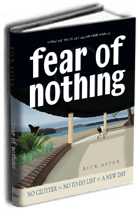I got my largest paycheck ever and I took on the challenge of spending it all. Instead I discovered that there were other factors limiting how much I could spend.
- Wish list
- I had imagined my wish list was endless. After a decade of an austerity budget, it is understandable that I might think that way. But in truth, I had already picked off the major items from my wish list one by one over the previous two years. My list was a page long, but there were some things I couldn’t find and others I didn’t really want anymore. When I bought the rest of the list, it was less than $1,000.
- Emotional indifference
- I mentioned that I passed over some of the items on my wish list. They weren’t so important as when I had originally written them down. I know from my own experience with clutter that I have to respect this feeling of indifference. It won’t improve my life to fill up my shelves with things I don’t really want, even if I have the money to buy them.
- Time
- Every way of spending money takes up time in one way or another. I bought the eight books on my wish list, but in two weeks I have barely opened them. Reading them would take days even if I had nothing else to do. Just making the purchase takes time, and that is especially true when something goes wrong. I spent more time on the two music CDs that didn’t arrive than on the seven that did. Often the time required for something is about as big as the money I spend. I want to get my hair colored, but that will happen only after I block out a few hours for the hair salon. When I went to buy shoes, I spent an hour going to three stores to find the right style in the right size. The purchases that will make the biggest difference in my daily life are the ones that have to be installed in the house. Some of the things I want to buy would require me to dedicate about a week to learning how to use them — an unlikely prospect as long as I am in my current work schedule. The more you insist on making sure you get something for the money you spend, the more time you have to put in.
- Timing
- Even when I know I want something, the timing may not be right. Probably there are more books I want to read, but shouldn’t I wait until I know I have time to read them? I would benefit from a better washing machine, but that and a list of other home upgrades will go more easily if I can postpone them until I have a chance to redo the house itself, assuming I can keep my current stuff going for a few more years. I think I want one more bookcase in the house, but I might change my mind after the next round of decluttering, so that too can wait. Paradoxically, knowing that I have enough money to buy something on a whim makes it easier to postpone the purchase for another week, another month, another year.
So far I have spent 41 percent of the paycheck, and I am starting to make a list of purchases and projects that will take up the rest of it. There is the hair color I mentioned and the trip to the beach I mentioned in an earlier post. There are a few much-needed home repairs that will take more time than money. These and other projects eventually add up to the sum I promised to spend, but realistically, all this will take some time to do. I will surely still be working my way through the list when I get the next paycheck ten weeks from now.
As long as so much depends on how much time I can put in, it makes sense that I should find ways to spend money in a way that saves me time. This too is harder to do than I would have guessed. Even time-saving purchases take time in the short run. But there are some answers, and even small things can make a difference.
The product that best symbolizes a time-saving purchase is sliced bread. If a loaf of bread is sliced by machine, that saves me the work of slicing the bread after I get home. The time saved is only a minute, but given the choice, I’ll take it. That is the kind of time-saving trade-off I am looking for.
Sometimes it is not the product itself, but the way I buy it. I might choose the store that is closer to home over the one that has the best prices. Online ordering goes faster if I can buy five products at once than if I order them one at a time.
A different kind of improvement comes about when I can upgrade, replacing one piece of equipment with another. The first example on my list is the power amplifier in my studio. The power amplifier provides the electrical power that moves the loudspeakers and delivers music into the room. I have been using a power amplifier that I happened to buy at a good price years ago. It works well enough but the newer ones are smaller, have better sound clarity, and use electricity more efficiently. The smaller size is important as I try to make the best use of my limited space. The electrical savings mean the investment will pay for itself in about ten years. This kind of purchase doesn’t take so much time because I don’t have to learn anything new. It is mainly a matter of unplugging one thing and plugging in another.
A smaller upgrade that has a more obvious time-saving component is the bedside lamp. Ideally, I should have a lamp that doesn’t make me reach so far for the light switch. This may save me five seconds every time I turn out the lights to go to sleep. The difference is not much, but in a year’s time that could mean another half hour of time, so it’s a worthwhile upgrade to make.
I don’t have a long list yet, but just searching for these upgrade opportunities is accomplishing the underlying goal of my spending challenge, which was to shed my austerity-budget thinking and change my relationship to money. Austerity thinking is a useful thing for getting through a financial squeeze, but it can hold a person back if the habit is still there after conditions have changed.



No comments:
Post a Comment